Virtual Solstice at Stonehenge
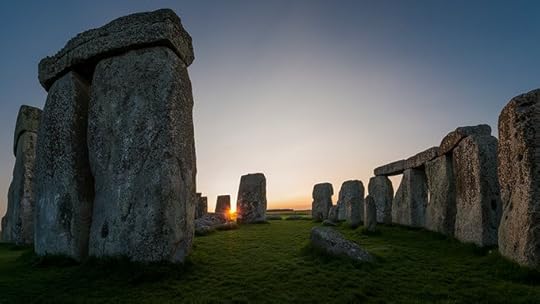 In normal times, thousands of people would flock to the iconic prehistoric stone monument of Stonehenge in Wiltshire, southwestern England to celebrate the Summer Solstice in a tradition that has been observed for millennia and still carries spiritual importance for modern-day pagans.
In normal times, thousands of people would flock to the iconic prehistoric stone monument of Stonehenge in Wiltshire, southwestern England to celebrate the Summer Solstice in a tradition that has been observed for millennia and still carries spiritual importance for modern-day pagans.Due to the coronavirus pandemic, however, English Heritage—the organization that manages the monument—cancelled the celebrations. In fact, Stonehenge has been closed since March 18, 2020, as the British government introduced measures to combat the coronavirus pandemic.
Instead, they provided a livestream of sunset and sunrise at Stonehenge on June 20 and June 21 respectively.
My husband and I hopped onto the live feed last night, along with about 50,000 other virtual visitors, to see the sunrise rays stream through the famous Neolithic monument. Unfortunately, the sunrise was masked by clouds. But Stonehenge is beautiful non-the-less, and it was interesting to watch the comments scroll along the live feed. People commented from South Africa, Australia, Brazil, Columbia, and all over Europe, as well as Canada and all points in the United States. Many of the viewers had been to the Summer Solstice celebration in previous years, and hoped they’d be able to attend again in person.
Stonehenge was built in three phases between about 3,000 B.C. and 1,600 B.C., and its purpose remains under study. However, it’s known that if you stand in just the right place inside the Stonehenge monument on the day of the northern summer solstice, facing northeast through the entrance towards a rough-hewn stone outside the circle—known as the Heel Stone—as illustrated in the image at the top.
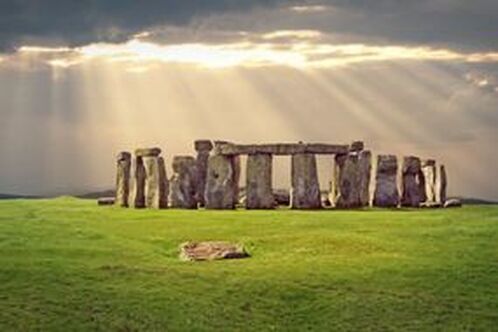 This huge monolith shows how carefully our ancestors watched the sun. Astronomical observations such as these probably controlled human activities such as the mating of animals, the sowing of crops, and the metering of winter reserves between harvests.
This huge monolith shows how carefully our ancestors watched the sun. Astronomical observations such as these probably controlled human activities such as the mating of animals, the sowing of crops, and the metering of winter reserves between harvests.While most are not a famous as Stonehenge, similar giant stone monuments and other structures are scattered throughout England, Ireland and Scotland. A predominance of those monuments are aligned with painstaking precision to the rising and setting of the sun.
When Stonehenge was first opened to the public, visitors were able to walk among the stones—even climb on them. The stones were roped off in 1977 as a result of serious erosion. Today, visitors to the monument are not permitted to touch the stones, but, if you go, you will be able to walk around the monument from a short distance away. Visitors can also make special bookings to access the stones throughout the year.
Two recently discovered pits have been found at Stonehenge which point to it once being used as a place of worship before the stones were erected. The pits are positioned on celestial alignment at the site and may have contained stones, posts or fires to mark the rising and setting of the sun.
An international archaeological survey team found the pits are part of the Stonehenge Hidden Landscapes Project. The team is using geophysical imaging techniques to investigate the site.
It is thought the pits, positioned within the Neolithic Cursus pathway, could have formed a procession route for ancient rituals celebrating the sun moving across the sky at the Midsummer Solstice.
Archaeologists also discovered a gap in the northern side of the Cursus, which may have been an entrance and exit point for processions taking place within the pathway. These discoveries hint that the site was already being used as an ancient center of ritual prior to the stones being erected 5,000 years ago.
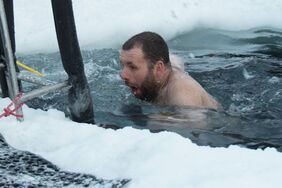 While June 21 is the summer solstice in Britain, for Australia and countries in the southern
While June 21 is the summer solstice in Britain, for Australia and countries in the southernhemisphere this date marks the winter solstice.
In Antarctica, members of the Australian Antarctic Division at the Casey research station marked the winter solstice with a traditional cutting through thick ice and taking a dip in the icy waters beneath.
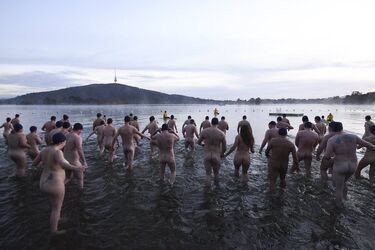 In Canberra, Australia, the winter solstice Nude Charity Swim took place in Lake Burley Griffin on the shortest day of the year.
In Canberra, Australia, the winter solstice Nude Charity Swim took place in Lake Burley Griffin on the shortest day of the year.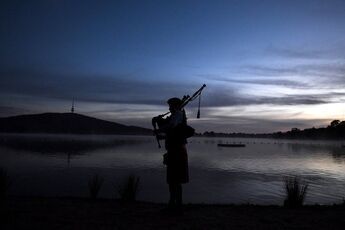 Swimmers were accompanied by a bagpipe player as dawn broke. In Northern Arizona, near Sedona, is a site used our Native people to celebrate the Summer Solstice, the V-Bar-V Ranch. Established as a historical site about ten years ago, the V-Bar-V is home to a well-preserved and beautiful petroglyph site, created by the Sinagua Indians sometime between 1150 and 1400 AD.
Swimmers were accompanied by a bagpipe player as dawn broke. In Northern Arizona, near Sedona, is a site used our Native people to celebrate the Summer Solstice, the V-Bar-V Ranch. Established as a historical site about ten years ago, the V-Bar-V is home to a well-preserved and beautiful petroglyph site, created by the Sinagua Indians sometime between 1150 and 1400 AD.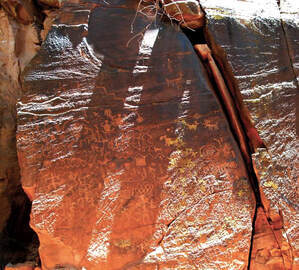 The photo was taken on location on June 21, first day of the summer solstice.
The photo was taken on location on June 21, first day of the summer solstice.Marking the passage of time across what is now believed to be a solar calendar or panel—one of very few worldwide—shadow stones naturally wedged in a rock crevice play light and shadow across the cliff face. The precise times of the vernal equinox and summer solstice, important events for planting and harvesting, are tracked by light and the sun’s transition across the southwestern sky.
No matter how you chose to celebrate (or not), I hope your Solstice was peaceful and full of warmth.
Published on June 21, 2020 19:06
No comments have been added yet.



